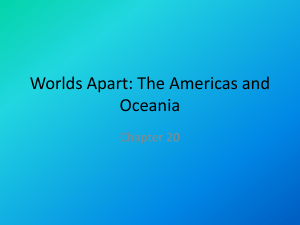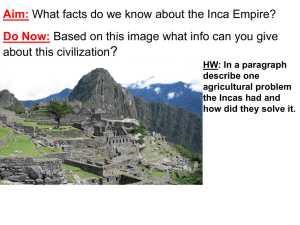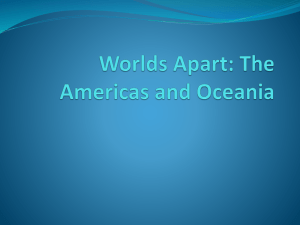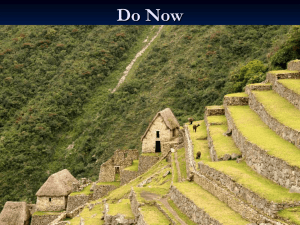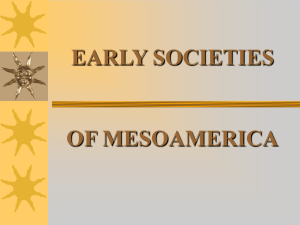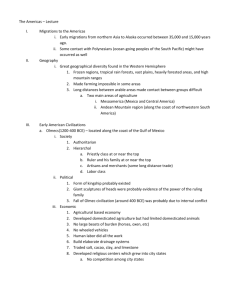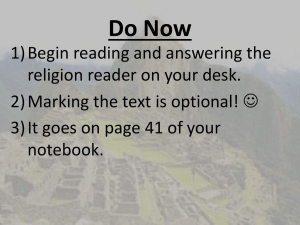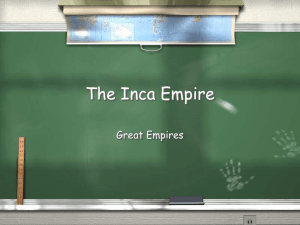Chapter 20 Notes - Fort Bend ISD / Homepage
advertisement
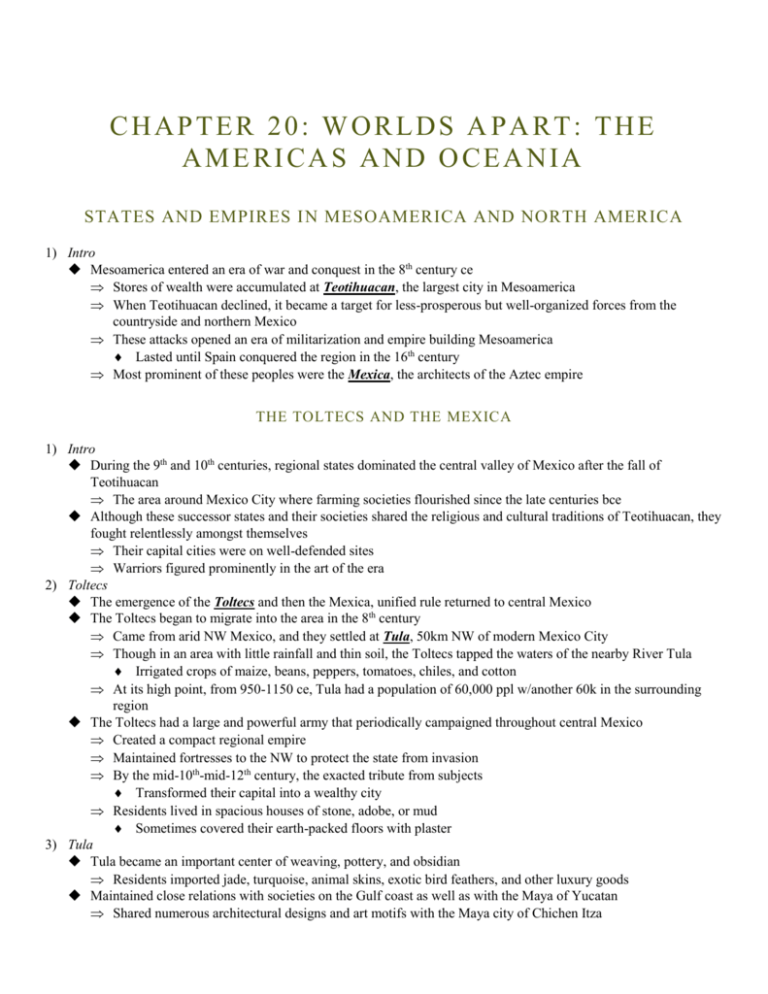
CHAPTER 20: WORLDS APART: THE AMERICAS AND OCEANIA STATES AND EMPIRES IN MESOAMERICA AND NORTH AMERICA 1) Intro Mesoamerica entered an era of war and conquest in the 8th century ce Stores of wealth were accumulated at Teotihuacan, the largest city in Mesoamerica When Teotihuacan declined, it became a target for less-prosperous but well-organized forces from the countryside and northern Mexico These attacks opened an era of militarization and empire building Mesoamerica Lasted until Spain conquered the region in the 16th century Most prominent of these peoples were the Mexica, the architects of the Aztec empire THE TOLTECS AND THE MEXICA 1) Intro During the 9th and 10th centuries, regional states dominated the central valley of Mexico after the fall of Teotihuacan The area around Mexico City where farming societies flourished since the late centuries bce Although these successor states and their societies shared the religious and cultural traditions of Teotihuacan, they fought relentlessly amongst themselves Their capital cities were on well-defended sites Warriors figured prominently in the art of the era 2) Toltecs The emergence of the Toltecs and then the Mexica, unified rule returned to central Mexico The Toltecs began to migrate into the area in the 8th century Came from arid NW Mexico, and they settled at Tula, 50km NW of modern Mexico City Though in an area with little rainfall and thin soil, the Toltecs tapped the waters of the nearby River Tula Irrigated crops of maize, beans, peppers, tomatoes, chiles, and cotton At its high point, from 950-1150 ce, Tula had a population of 60,000 ppl w/another 60k in the surrounding region The Toltecs had a large and powerful army that periodically campaigned throughout central Mexico Created a compact regional empire Maintained fortresses to the NW to protect the state from invasion By the mid-10th-mid-12th century, the exacted tribute from subjects Transformed their capital into a wealthy city Residents lived in spacious houses of stone, adobe, or mud Sometimes covered their earth-packed floors with plaster 3) Tula Tula became an important center of weaving, pottery, and obsidian Residents imported jade, turquoise, animal skins, exotic bird feathers, and other luxury goods Maintained close relations with societies on the Gulf coast as well as with the Maya of Yucatan Shared numerous architectural designs and art motifs with the Maya city of Chichen Itza 4) 5) 6) 7) Beginning about 1125 ce, the Toltec empire faced serious difficulties as conflicts between the different ethnic groups at Tula led to strife By the mid-12th century, large numbers of migrants had entered Tula and settled the surrounding area Mostly nomads from NW Mexico By 1175, the comination of civil conflict and nomadic invasion had destroyed the Toltecs Evidence suggests that fire destroyed much of Tula around the same time Large numbers of ppl continued to inhabit the region around Tula By the end of the 12th century the Toltecs no longer dominated Mesoamerica The Mexica Among the migrants drawn to central Mexico from NW regions were the Mexica Often referred to as the Aztecs because they dominated the alliance that built the Aztec Empire in the 15th century Arrived in central Mexico around the middle of the 13th century Had a reputation for trouble by kidnapping local women and seizing land already cultivated by others On several occasions their neighbors forced them to move For a century, they migrated around central Mexico, fighting other peoples and sometimes surviving only on fly eggs and snakes Tenochtitlan About 1345, the Mexica settled on an island in a marshy region of Lake Texcoco Founded the city of Tenochtitlan, their capital, which would be the foundation of Mexico City While originally inconvenient, the site was advantageous The lake had lots of fish, frogs, and waterfowl The lake enabled the Mexica to develop the chinampa system of farming The Mexica dredged a rich and fertile muck from the lake’s bottom, and built it up into small plots of land known as chinampa During te dry season, cultivators tapped water from canals from the lake to their plots In the temperate climate they grew crops of maize, beans, squashes, tomatoes, peppers, and chiles year round Chinampas were so fertile and productive that cultivators were able to harvest seven crops per year from their gardens The lake also served as a natural defense Waters protected Tenochtitlan on all sides Mexica warriors patrolled the three causeways that linked the capital with the surrounding area The Aztec Empire By the early 15th century, the Mexica were powerful enough to overcome their immediate neighbors and demand tribute During the middle decades, the Mexica launched campaigns of imperial expansion Under the rule of Itzcoatl (1428-1440) and Moctezuma I (1440-1469) (Montezuma), they advanced against Oaxaca in the SW Mexico After conquering them, they populated Oaxaca with colonists The city became a bulwark for the Mexica empire The Mexica then turned to the Gulf coast, whose tropical products made tribute items in Tenochtitlan Finally, they then conquered the high plateaus between Tenochtitlan and the Gulf coast About the mid-15th century, the Mexica allied with two neighbors, Texcoco and Tlacopan, to create a triple alliance that guided the Aztec empire Dominated by the Mexica and Tenochtitlan, the allies imposed their rule on about 12 million people and most of Mesoamerica Excluded the arid northern and western regions and a few pockets of independence Tribute and Trade The amin objective of the triple alliance was to exact tribute from subjects From nearby peoples the Mexica and their allies received food and manufactured items such as textiles, rabbit-fur blankers, embroidered clothes, jewelry, and obsidian knives Tribute obligations were sometimes oppressive for subject peoples Ruling elites entrusted some of the tribute items to officially recognized merchants Took them to distant lands and exchanged them for local products (jade, emeralds, tortoise shells, jaguar skins, parrot feathers, seashells, and game) Also supplied vanilla beans and cacao from the tropical lowlands, which was the source of tasty chocolate drinks Unlike imperial states in the eastern hemisphere, the Aztec empire had no elaborate bureaucracy or administration The Mexica and their allies conquered their subjects and assessed tribute Left local gov’t and collection of tribute to local peoples Their allies did not even maintain military garrisons Nor did they establish a standing army Assembled forces as needed when they launched campaigns of expansion of mounted punitive expeditions against insubordinate subjects The Mexica had a reputation for military prowess Fear of reprisal kept most subjects in line At the high point of the Aztec empire in the early 16th century, tribute from 489 subject territories flowed into Tenochtitlan The Mexica capital had 200,000 ppl, and 300,000 others lived in nearby towns and suburban areas MEXICA SOCIETY 1) Intro More information survives about the Mexica than any other people in the pre-Columbian Americas Mexica books survived the Spanish caonquest, offering direct testomny about the Mexica way of life A great deal survived from interview conducted by Spanish missionaries during the mid-16h century 2) Social Structure Mexica society was rigidly hierarchical Public honors and rewards mostly went to the military elite The Mexica looked at all males as potential warriors Individuals of common borth could distinguish themselves via combat For the most part, military elite cam from the Mexica aristocracy Had the best opportunity to display their talents on the battlefield 3) Warriors The Mexica showered wealth and honors on their military elite Accomplished warriors received extensive land grants Received tribute from commoners The most successful warriors formed a council whose members selected the ruler, discussed public issues, and filled gov’t positions Ate the best food, consumed the most luxurious items Commoners had to wear coarse, burlap garments; aristocrats could wear cotton Warriors could wear brightly colored capes and adorn themselves with lip plugs and eagle feathers 4) Mexica Women Women played almost no role in the political affairs of a society dominated by military values Wielded influence within the families and enjoyed high honors as mothers of warriors Did not inherit property of hold official positions The law subjected them to the strict authority of their fathers and their husbands Women were prominent in the marketplaces, as well as in crafts with embroidery and needlework Society prodded them toward motherhood With the exception of a few who dedicated themselves to the temple, all Mexica women married Principal function was to bear children, especially males who could become warriors Society recognized the bearing of children as equal to a warrior’s capture of enemy in battle Women who died in childbirth won the same fame as warriors who died on the battlefield Women in all classes had the responsibility of raising young children and preparing food for their families 5) Priests In addition to the military aristocracy, a priestly class also ranked among the Mexica elite Received a special education in calendars and ritual lore Presided over religious ceremonies the Mexica viewed as crucial to the continuation of the world Read omens, explained the forces that drove the world Wielded considerable influence as advisors to Mexica rulers Some priests even became the supreme rulers of the Aztec empire Montezuma II (r. 1505-1520) was a priest 6) Cultivators and Slaves The bulk of the Mexica population consisted of commoners who lived in hamlets who cultivated chinampas and fields allocated to their families by community groups known as calpulli Calpulli were originally clans of families w/descent from a common ancestor; eventually became more about living in a tight-knit community Organized their own affairs and allocated community property to individual families Apart from working their plots, commoners also worked on lands awarded to aristocrats or warriors Contributed labor services to public work projects involving the construction of palaces, temples, roads, and irrigation systems Cultivators delivered periodic tribute payments to state agents Would distribute them a portion of what they collected to the elites and stored the remainder in granaries and warehouses Mexica society also included slaves who usually worked as domestic slaves Most slaves were no foreigners, but Mexica Families sometimes sold younger members into servitude to do financial distress Others were forced into it due to criminal behavior 7) Artisans and Merchants Skilled artisans, esp those with gold, silver, textiles, tropical bird feathers, and others designed for consumption by the elites, enjoyed prestige in Mexica society Merchants of long-distance trade occupied an important but tenuous position Supplied the exotic products consumed by elites [rovided political and military intelligence However, the often fell under suspicion as greedy profiteers Aristocrats frequently extorted wealth and goods from weak merchants MEXICA RELIGION 1) Intro When they migrated to central Mexico, the Mexica already spoke the Nahuatl language Had been the prevalent tongue in the region since the TOltecs Soon adopted other cultural and religious traditions, some of which dated from the Olmecs Most Mesoamericans played a ball game Maintained a complicated calendar based on a solar year of 365 days and a ritual year of 260 days 2) Mexica Gods The Mexica also absorbed the religious common to Mesoamerica Two of their principle gods had been in Mesoamerica since Teotihuacan Tezcatlipoca “The Smoking Mirror”, and Quetzalcoatl “The Feathered Serpent” Tezcatlipoca was a powerful figure, the giver and taker of life and the patron deity of warriors Quetzalcoatl had a reputation for supporting arts, crafts, and farming 3) Ritual Bloodletting Like their predecessors, the Mexica believed that their gods had set the world in motion through individual sacrifice By letting their blood flow, the gods had given the earth the moisture it needed to grow maize and other crops To propitiate the gods and ensure the continuation of the world, the Mexica honored their deity through sacrificial blood-letting The priests regularly provided acts of self-sacrifice, piercing their earlobes or penises with cactus spines The religious beliefs and bloodletting clearly reflected the desire of the Mexica to keep their agricultural society going 4) Huitzilopochtli Mexica priests also presided over the sacrificial killing of human victims From the Olmecs and possible before, Mesoamerican peoples had regarded the ritual sacrifice of humans as essential to the world’s survival The Mexica, placed much more emphasis on human sacrifice than their predecessors had To a large extent the Mexica enthusiasm for human sacrifice followed from their devotion to the god Huitzilopochtli Mexica warriors took him as their patron deity in the early years of the 14th century as they subjected neighboring peoples to their rule Military success persuaded them that the god especially favored the Mexica As military success mounted, the priests of his cult demanded sacrificial victims to keep the war god appeased Some of the victims were Mexica criminals, but others came as tribute from neighboring peoples or from the ranks of warriors captured on the battlefield during the many conflicts between the Mexica and their neighbors In all cases, the Mexica viewed human sacrifice not as a gruesome form of entertainment Rather, a ritual essential to the world’s survival PEOPLES AND SOCIETIES OF NORTH AMERICA 1) Intro Beyond mexico the peoples of North America developed a variety of political,social, and economic traditions In the arctic and subarctic regions, diets included sea mammals (whale, seal, and walrul) Supplemented by land mammals such as moose and caribou Peoples in coastal region consumed fish, but in interior regions (the North American plains), they hunted large animals such as bison and deer Throughout the continent, nuts, berries, roots, and grasses such as wild rice supplemented the meat provided by hunters and fishers Like their counterparts, peoples of North America built societies on a small scale since wild food wouldn’t support large populations 2) Pueblo and Navajo Societies In several regions of North America, farming economies enabled peoples to maintain settled societies with large populations In what is now the American SW, Pueblo and Navajo peoples tapped river waters to irrigate crops of maize, which were as much as 80% of their diets Cultivated beans, squash, and sunflowers Supplmeneted their crops with wild plants and small game such as rabbit The hot and dry climate brought drought and famine By about 700 ce, the Pueblo and the Navajo began to construct permanent stone and adobe buildings 3) Iroquois Peoples Large-scale farming societies emerged in the woodlands east of the Mississippi River Woodlands ppl began to cultivate maize and beans during the early centuries ce About 800 ce these cultivated foods made up the bulk of their diets Lived in settled communities, and they often surrounded their larger settlements with wooden palisades as defensive walls By 1000, the Owasco ppl had a distinct society in upstate NY By 1400 ce, the five Iroquois nation had emerged from Owasco society Women were in charge of Iroquois villages and longhouses (where several families lived together) Supervised cultivation of fields surrounding the settlements Men took responsibility for affairs beyond the village- hunting, fishing, and war 4) Mound-Building People The most impressive structure of the woodlands peoples were the enrormous earthen mounds that dotted the countryside throughout the eastern half of North America Woodlands peoples used those mounds sometimes as stages for ceremonies and rituals, often as platforms for dwellings, and occasionally as burial sites 5) Cahokia The largest surviving structure in a mound as Cahokia near east St. Louis, Illinois Third-largest structure in the western hemisphere before the arrival of Europeans Scholars estimate that during the 12th century, 15k to 38k people lived in the vicinity of the Cahokia mounds 6) Trade Bc peoples north of Mexico had no writing, info about them comes from archaeological discoveries Burial sites reveal that mound-building peoples recognized various social classes, since they bestowed grave goods of different quality and quantities Archaeologists have shown that trade linked widely separated regions and peoples of north America An elaborate network of rivers facilitated travel and trade by canoe in the eastern half of north America Stones from the Rockies, copper from the Great Lakes, seashells from Florida, mineral from the upper Mississippi, and mica from the southern Appalachian appeared in the woodlands The community at Cahokia probably owed its size and prominence to its location at the hub off the North American trade networks STATES AND EMPIRES IN SOUTH AMERICA 1) Intro South American peoples had no script and no tradition of writing before the arrival of Spanish invaders in the early 16th century As a result, the experiences of early South American societies are more difficult to recover than Mesoamerica Writing has been in use since the 5th century bce Had been the site of complex societies since the first millennium bce Cities and secular gov’t in South America began to overshadow ceremonial centers and priestly regimes from 1000-1500 ce Toward the end of the period, the Incas build a powerful state, extended their authority over a vast region, and established the largest empire ever in South America THE COMING OF THE INCAS 1) Intro After the disappearance of the Chavin and Moche societies, a series of autonomous regional states organized public affairs in Andean South America The states frequently clashed, but none rarely gained a long-term advantage over the others For the most part they controlled areas of mountainous highlands or in the valleys and coastal plains 2) Chucuito After the 12th century, the kingdom of Chucuito dominated the highlands around Lake Titicaca Depended on the cultivation of potatoes and the herding of llamas and alpacas In elaborately terraced fields built with stone retaining walls, cultivators harvested potatoes Served as the staple of the highlanders’ diet Apart from meat, llamas and alpacas provided the highlanders with wool, hides, and dung, widely used as fuel In exchange for potatoes and woolen tectiles, the highlanders got maize and coca leaves from societies in lower valleys Used maize to enhance their diets and to brew a alcoholic beverage Chewed their coca leaves, which worked as a mild stimulant and enhanced stamina in the thin air of the high Andes 3) Chimu In the lowlands the powerful kingdom of Chimu (Chimor) emerged in the 10th century and expanded to dominate 900 km (560 miles) of the Peruvian coast before the Incas in the mid-15th century Governed a large and thriving society Irrigation networks tapped the rivers and stream of the Andes Watered fields in lowlands Helped generate abundant yields of maize and potatoes Enjoyed considerable wealth and recognized clear distinctions between social classes Chimu’s capital, Chanchan, had a population over 50k (maybe 100k) Featured massive brick buildings, which indicated a capacity for mobilizing large #s of people and resources for public purposes The city’s geography reflected a well-defined social order Each block was an individual clan that supervised the affairs of its members and coordinated their efforts with those of other clans For several centuries, regional states maintained order in Andean South America Within a period of 30 years, these and other regional states fell under the domination of the Incas The word Inca was the title of the rulers of a small kingdom in the valley of Cuzco In modern usage, it refers to those who spoke the Quechua language, or even all subjects of the Inca empire 4) The Inca Empire After a long period of migration in the highlands, the Inca settled around Lake Titicaca in the mid-13th century At first, they lived as one among many peoples inhabiting the region About 1438, the Inca ruler Pachacuti (r. 1438-71) launched a seris of military campaigns that expanded the Incas’ authority First extended control over the southern and northern highlands Turned his forces on the coastal kingdom of Chimu Had to submit to the Incas when Pachacuti gained control of the water supply for their irrigation systems By the late 15th century, the Incas had built a huge empire more than 2,500 miles long from Quito to Santiago Embraced parts of Peru, Exuador, Bolivia, Chile and Argentina Only the tropical rainforests of the Amazon and other river valleys set a limit to Inca expansion to the east With a population of 11.5 million, the Inca Empire was the largest state ever built in South America The Incas ruled as a military and admin elite Led armies composed mostly of conquered peoples Staffed the bureaucracy that manages the empire’s political affairs Were not numerous enough to overcome their subjects Routinely sought to encourage obedience among subject peoples by taking hostages from the ruling classes and forcing them to live at the Inca capital When conquered peoples became retstive, the Incas sent loyal subjects as colonists, provided them with choice land and economic benefits, and established them in garrisons to maintain order When conquered peoples rebelled, the Inca forced them to leave their homes and resettle in distant lands 5) Inca Administration The vast realm provided a serious admin challenge The admin structure was invented by Pachacuti Pachacuti entrusted military affairs to his son around 1463, settled in the highland village of Cuzco, and designed a system of gov’t to consolidate his conquests Implemented taxes to support Inca rulers and administrators Organized a system of state-owned storehouses to stock agricultural surpluses and craft products Began construction on an extensive network of roads that enabled Inca military forces and administrators to travel quickly and to all parts of the empire 6) Quipu In tbe absence of any script or writing, Inca bureaucrats and admin relied on a mnemonic aid known as quipu To keep track of their responsibilities AN array of small cords of various colors and lengths, all suspended from on large, thick cord Most quipu recorded statistical info having to do with population, state property, taxes, and labor services that communities owed to the central gov’t Occasionally, quipu also helped experts remember historical info having to do with the establishment of the Inca empire, the Inca rulers, and their deeds Although much more unwieldy and less influential than writing, quipu enabled Inca bureaucrats to keep track of information well enough to run an orderly empire 7) Cuzco Cuzco served as the admin, religious, and ceremonial center of the Inca empire When Pachacuti retired there, Cuzco was a modest village, but the conqueror transformed it into a magnificent capital that Incas considered “the navel of the universe” The city’s permanent population was not huge due to it primarily being a capital Some 200k lived in the surrounding area Apart from imperial administrators, the most prominent permanent residents were the Inca rulers and high nobility, the high priests of various cults, and the hostages of conquered peoples 8) Inca Roads A magnificent and extensive road systems enabled the central gov’t at Cuzco to communicate with all parts of the Inca empire and to dispatch large military forces rapidly to distant trouble spots Two roads linked the Inca realm from north to south Inca roads were among the best ever built before modern times Paved with stone, shaded by trees, wide enough for 8 horsemen A corps of official runners carried messages along the roads so that news and info could travel between Cuzco and the most distant parts of the empire within a few days The roads favored their efforts at centralization Their roads even facilitated the spread of the Quechua language and their religious cult focusing on the sun INCA SOCIETY AND RELIGION 1) Trade Despite the splendid roads, Inca society did not generate large classes of merchants and skilled artisans On the local level the Incas and their subjects bartered surplus farming production and handcrafted goods among themselves Long-distance trade fell under the supervision of the central gov’t Admin organized exchanges of farming products, textiles, pottery, jewelry, and craft goods The Inca state did not permit individuals to become independent merchants In the absence of a market economy, there was no opportunity for a large class of professional, skilled artisans to emerge Many individuals produced pottery textiles, and tools for local consumption A few produced fine goods for the ruling, priestly, and aristocratic classes Skilled crafts workers were much less prominent among the Incas than among the Mexica and people of the Eastern Hemisphere 2) Ruling Elites The main classes in Inca society were the rulers, the aristocrats, the priests, and the peasant cultivators of common birth The Incas considered their chief ruler a deity descended from the sun This god-king owned all land, livestock, and property in the Inca realm 3) 4) 5) 6) Governed as an absolute and infallible ruler Inca rulers retained their prestige even after death Their descendants mummified the royal remains and regarded as departed kings intermediaries with gods Succeeding rulers often deliberated state policy in the presence of royal mummies The Inca god-kings supervised a class of bureaucrats, mostly aristocrats, who allocated plots of land for commoners to cultivate on behalf of their state Aristocrats and Priests Like the ruling elites, Inca aristocrats and priests led privileged lives Aristocrats consumed fine foods and dressed in embroidered clohes provided by common subjects Wore large ear spools that distinguished their lobes Priests often came from royal and aristocratic families Led celibate and ascetic lives Deepl influence Inca society because of their education and their responsibility for overseeing religious rituals The major temples supported hundreds of priests, along with attendants and virgin women Peasants The cultivators were mostly peasants of common birth who lived in communities known as ayllu, similar to the Mexicas’ calpulli Basic units of rural society From small villages to towns, ayllus were several families who lived together, sharing land, tools, animals, crops, and work Peasants supported themselves by working on lands allocated to individual families by their ayllu Instead of paying taxes or tribute, peasants also worked on state lands administered by aristocrats Much of the production from these state lands went to support the ruling, aristocratic, and priestly classes The rest went into state storehouses for public relief in times of famine and for the support of widows, orphans, and others unable to cultivate land for themselves Apart from farming work, peasants also owed compulsory labor services to the Inca state Men provided heavy labor for construction, maintenance, and repair of roads, buildings, and irrigation systems Women delivered tribute in the form of textiles, pottery, and jewelry With the aid of quipu, Inca bureaucrats kept track of the labor service and tribute owned by local communities Inca Gods: Inti and Viracocha Members of the Inca ruling class venerated the sun as a god and as their major deity whom they called Inti They also recognized the moon, stars, planets, rain, and other natural forces as divine Some Incas, including the energetic ruler Pachacuti, also showed special favor to the god Viracocha, creator to the world, humankind, and all else in the universe The cult of the sun was the most important In Cuzco alone, some 4,000 priests, attendants, and virgin devotees sered Inti, whose temple attracted pilgrms from all parts of the Inca empire Priests of Inti and other cults honored their deities with sacrifices, which in Inca society usually took the form of farming produce or animals such as llamas and guinea pigs rather than humans Moral Thought In addition to sacrifices and ritual ceremonies, Inca religion had a strong moral dimension Taught a concept of sin as a violation of the established social or natural order Believed in a life beyond death, where individuals would receive rewards or punishments based on the quality of their earthly lives Sin, they believed, would bring divine disaster both for individuals and for their larger communities Incas observed rituals of confession and penance by which priests absolved indiviudals of their sins and returned them toe good graces of gods THE SOCIETIES OF OCEANIA 1) Intro Inhabitants of Oceania did not interact with peoples of different societies as frequently or systematically as did their counterparts in the eastern hemisphere Built and maintain flourishing societies of their own The aboriginal peoples of Australia ventured over vast stretches of their continent and created networks of trade and exchange between hunting and gathering societies Only in the far north did they deal with peoples beyond Australia Traded sporadically with New Guinea and the islands of SE Asia Throughout the Pacific Ocean, Islanders built complex farming societies By the time Europeans sailed there in the 16th century, the larger island groups had sizable populations, hierarchical social orders, and hereditary chiefly rulers In the central and western Pacific, mariners sailed between island groups and established elaborate trade networks Islanders living toward the eastern and western edges of the Pacific Ocean also had dealings with American and Asian peoples, sometimes with significant consequences THE NOMADIC FORAGERS OF AUSTRALIA 1) Intro After the aboriginal peoples of Australia learned how to exploit the resources of the continent’s varied regions, they led lives that in some ways changed little over the centuries They did not turn to farming Inhabitants of New Guinea began to herd swine and cultivate root crops about 5000 bce and the inhabitants of the islands in the Torres Strait took up gardening after Although aboriginal peoples of northern Australia must have known about foods cultivate in neighboring lands, they maintained nomadic, foraging societies until European peoples migrated to Australia in large numbers during the 19th and 20th centuries 2) Trade As a result of their mobile and nomadic ways, aboriginal Australians frequently met and interacted with peoples of neighboring societies Due to its ecological and climate diversity, different peoples enjoyed access to food and other resources unknown to others they encountered during their seasonal migrations Even though as nomads they did not accumulate large quantities of material goods, groups regularly exchanged surplus good and small items when they met That sort of small-scale exchange eventually enabled trade goods to spread throughout most of Australia Individuals did not travel along all the trade routes Instead, trade goods passed from one aboriginal community to another until they came to rest in regions distant from their origins Baler and oyster pearl shells among the most popular trade items Aboriginal peoples occasionally traded food, but these items were generally too perishable for exchange Peoples on the north coast engaged in a limited amount of trade with mariners from New Guinea and the islands of SE Asia 3) Cultural and Religious Traditions In spite of seasonal migrations, frequent encounters with peoples from other aboriginal societies, and trade over long distances, the cultural traditions of Australian peoples mostly did not diffuse much beyond the regions inhabited by individual societies Aboriginal peoples paid close attention to the prominent geographic features of the lands around them Rocks, mountains, forests, mineral deposits, and bodies of water were crucial for their survival Related stories and myths about those and other geographic features Often conducted religious observances designed to ensure continuing supplies of animals, plant life, and water Given the intense concern of aboriginal peoples with their immediate environments, their cultural and religious traditions focused on local matters and did not appeal to peoples from other religions THE DEVELOPMENT OF PACIFIC ISLAND SOCIETIES 1) Intro By the early centuries ce, human migrants had established farming societies in almost all the island groups of the Pacific Ocean About the middle of the 1st millennium ce, they ventured to the large islands of New Zealand, the last large habitable place on earth to receive members of humans After 1000 ce, Polynesians inhabiting the larger Pacific islands grew especially numerous Their surging pop promoted social and political development 2) Trade Between Island Groups In the central and western regions of the Pacific, mariners linked island societies Regional trade facilitated exchanges of useful goods such as axes and pottery Exotic items like shells and decorative ornaments Foodstuffs like yams Regional trade within individual island groups served social and political as well as economic functions Helped ruling elites establish and maintain harmonious relations with one another Trade crossed longer distances and linked different island groups Inhabitants of the Tonga, Samoa, and Fiji islands traded mates and canoes and also intermarried, creating political and social relationships 3) Long-Distance Voyaging Elsewhere in Polynesia, vast stretches of deep blue water made it much more complicated to travel between different island groups and societies Regular trade did not emerge in the eastern Pacific Ocean Nevertheless, mariners undertook lengthy voyages on an intermittent basis, sometimes with huge results After the original settlement of Easter Island about 300 ce Probably ventured to the coast of South America where they learned about the cultivation of sweet potatoes Between about 400-700 ce, mariners spread sweet potatoes throughout Polynesia and beyond to New Caledonia and Vanuatu The new crop became a prominent food source in all the islands it reached Especially important for the Maori people of New Zealand Staple crops of the Pacific did not flourish in new Zealand Long-distance voyages were responsible for the dissemination of sweet potatoes to remote islands Another case of long-distance voyaging prompted social changes in the Hawaiian islands For centuries that brought the original settles to the islands in the early centuries ce, there was little travel or communication between Hawaii and other Polynesian societies During the 12th and 13th centuries, a series of two-way voyages survive in oral traditions that relate the introduction into Hawaii of new chiefly and priestly lines from Tahiti 4) Population Growth Islanders also built productive farming and fishing societies Cultivated taro, yams, sweet potatoes, bananas, breadfruit, and coconuts Kept domesticated chicken, pigs, and dogs Fed on abundant fish caught with spear net or hook After the 14th century, as their population increased, Hawaiians built fishponds that allowed small fish to swim through narrow gates into rock-enclosed spaces but prevented larger fish from escaping Enabled Hawaiians to harvest large quantities of mature fish with ease, increasing food supplies Establishment of fishing and farming societies led to rapid pop growth in all the larger Pacific island groups 5) 6) 7) 8) 500k in Hawaii when Europeans arrived in late 18th century Dense populations sometimes led to environmental degradation and social strife on small islands with limited resources Easter Island in particular was a site of problems stemmed from overpopulation Polynesian migrants originally settled Easter island in the early centuries ce During the era from 1100-1500, their descendants numbered about 10k This pop placed tremendous pressure on the island’s resources and also competed fiercely among themselves for those resources By 1500, having divided into hostile camps, islanders fought one another ferociously Nan Madol In other lands, dense pop promoted social org on a new scale Oh Pohnpei in the Caroline Islands, the Sandeleur dynasty built a powerful state and organized construction of a massive stone palace and admin center at Nan Madol 93 artificial islets protected by seawall and breakwater on three sides Development of Social Classes Beginning about the 13th century, expanding pop prompted residents of many Pacific islands to develop complex social and political structures Especially on the larger islands, workers became more specialized Some concentrated on cultivating crops, others fished, produced axes, or constructed canoes Distinct classes emerged as aristocratic and ruling elites decided the course of public affairs in their societies Extracted surplus farming production from those of common birth Tonga, Tahiti, and Hawaii had stratified societies with sharp distinctions between various vlasses Hawaiian society also recognized distinct classes of priests and skilled artisans between the chiefly and common classes The Formation of Chiefly States In addition to distinct social classes, island societies generated strong political leadership Ruling chiefs oversaw public affairs in portions of an island, an entire, or several islands In Tonga and Hawaii, high chiefs launched campaigns to bring additional islands under their control and create large centralized states Rarely were these chiefs able to overcome geographic and logistic difficulties and realize their expansionist ambitions High chiefs guided the affairs of complex societies throughout Polynesia Allocated lands to families, mobilized labor for construction projects, organized men into military forces Commanded respect within society In Hawaii, the classes of high chiefs known as ali’I nui intermarried, ate the best fish and food that was kapu (“taboo”) to others Had the right to wear clocks with bright red and yellow bird feathers Polynesian Religion High chiefs claimed their power descended directly from the gods Worked closely with priests who served as intermediaries between humans and the gods Gods of war and farming were common throughout the Pacific islands, but individual islands and island groups recognized deities particular to their own regions and interests The most distinctive architecture of early Pacific societies was the ceremonial precinct and temple structures known as marae In Tonga and Samoa, temples of timber and thatched roofs Open-air courtyards in eastern Polyensia Pacific island societies didn’t enjoy access to the range of tech developed by continental peoples until the 16th and later centuries Pacific islanders cleverly exploited their environments, established productive farming economies, built elaborate, well-organized societies, and reached out when pssible to engage in trade with their neighbors Their achievements testify anew to the human impulses toward densely populated communities and interaction with other societies
